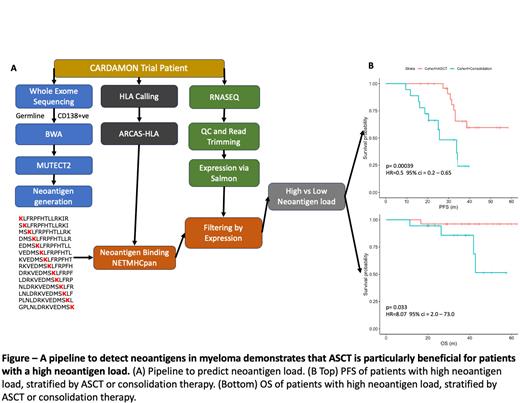Autologous stem cell transplant (ASCT) is the current standard of care for eligible patients with multiple myeloma (MM). The UK national trial CARDAMON investigated whether, following carfilzomib, cyclophosphamide, and dexamethasone (KCD) induction, ASCT was of benefit compared with further cycles of KCD as consolidation. All patients received carfilzomib maintenance. KCD consolidation did not show non-inferiority, but the difference was marginal, and we previously concluded “that further studies are warranted to explore deferred autologous HSCT in some subgroups.” Whilst some of the benefit of ASCT derives from the myeloablative effect of melphalan, there is evidence that immune reprogramming has an important role. It has also been reported that neoantigen burden has prognostic significance in MM, with patients with a high neoantigen load having worse outcomes. Taken together, we hypothesized that patients with higher neoantigen load would gain most benefit from ASCT, due to immune reprogramming.
We therefore developed a pipeline to predict neoantigen load in myeloma patients ( Fig. 1A) and explored whether this had prognostic significance in the context of consolidation or ASCT in patients enrolled in CARDAMON. We collected paired tumour and germline whole exome sequencing and RNA-Seq data. We called nonsynonymous and frame-shift mutations using MuTECT2 and calculated RNA-Seq expression using Salmon. We used ARCAS-HLA for HLA genotyping. We translated high-confidence mutations within a sliding window and predicted HLA allele binding using NETMHCpan-4.0, predicting binding when the IC50 was less than 200nM, per the standard definition of a strong binding peptide. We removed any neoantigens that were not expressed, using the RNA-Seq data. Neoantigen load for an individual patient was taken as the number of predicted expressed neoantigens. We chose a neoantigen cut-off based on mutation rates distinguishing immunologically “cold” or “hot” tumours. Consequently, patients with <= 130 neoantigens were defined as low antigen load, and those with >130 were defined as high neoantigen load.
We observed a total of 15,162 high affinity neoantigens across 58 patients, with a median of 200 neoantigens per patient (range 34 - 653). Forty-six neoantigens were shared across patients, mostly NRAS, KRAS, and BRAF. We first compared patients by randomization group. For patients who received consolidation, there was no significant difference in progression-free survival (PFS) between high and low antigen loads (p=0.32). For patients in the ASCT arm, a high antigen load was associated with a longer PFS (p=0.013). This was surprising, as high antigen load has previously been shown to be a poor prognostic factor, although our numbers were small and confirmation in independent data is ongoing. We then considered patients split by antigen load. For those with low antigen load, we saw no difference in PFS between those who received ASCT and those who received consolidation. However, for patients with a high antigen load, there was a marked improvement in PFS for those undergoing ASCT ( Fig. 1B Upper; median PFS not reached vs. 25 months; hazard ratio 0.50, 95% confidence interval 0.20-0.65; p=0.0039). This difference translated to overall survival ( Fig. 1B Lower; median OS not reached in either group; hazard ratio 0.12, 95% confidence interval 0.014-0.50; p=0.028).
The marked benefit of ASCT over consolidation in this subgroup analysis is in contrast to the marginal difference between the two therapies for allcomers in the CARDAMON trial. Whilst upfront ASCT remains the treatment of choice for eligible patients, the risk/benefit ratio may be less clear in the more frail and in the context of deep response to induction.
In summary: We have developed a bioinformatic pipeline to predict neoantigen burden in newly diagnosed myeloma, which suggests higher neoantigen load is associated with a major benefit from ASCT. This approach provides novel insight into the biology of ASCT and could be used to stratify patient need for ASCT in the future, although the immunological mechanisms implicated in these findings remain to be identified. Neoantigen subtype effect (frameshift vs SNV) and validation in a larger cohort is ongoing.
Disclosures
Walker:Janssen: Honoraria; Abbvie: Honoraria. Popat:GSK: Consultancy, Honoraria, Research Funding; Abbvie: Honoraria; BMS: Honoraria; Janssen: Honoraria; Roche: Honoraria. Ramasamy:AbbVie, Adaptive Biotechnologies, Amgen, Celgene (BMS), GSK, Janssen, Karyopharm, Oncopeptides, Pfizer, Sanofi, Takeda, Recordati pharma, Menarini Stemline: Speakers Bureau; Pfizer, GSK: Membership on an entity's Board of Directors or advisory committees; AbbVie, Adaptive Biotechnologies, Amgen, Celgene (BMS), GSK, Janssen, Karyopharm, Oncopeptides, Pfizer, Sanofi, Takeda Recordati pharma, Menarini Stemline: Honoraria; Amgen, Celgene (BMS), GSK, Janssen, Takeda: Research Funding. Phillips:Takeda: Other: Travel support; Celgene: Other: Travel Support; Gilead: Other: Speaker Fees; Takeda: Other: Speaker Fees. Clifton-Hadley:Astra Zeneca, GSK, Pfizer, MSD, BMS, Amgen, Millennium Takeda: Research Funding. Chapman:Celgene (BMS): Membership on an entity's Board of Directors or advisory committees; Sanofi: Honoraria.


This feature is available to Subscribers Only
Sign In or Create an Account Close Modal